#1700s menswear
Explore tagged Tumblr posts
Text



Beige Wool Coat, 1695-1705, English.
Victoria and Albert Museum.
#beige#wool#coat#menswear#1695#1690s#1700s#17th century#18th century#1690s menswear#1690s coat#1700s menswear#1700s coat#1690s England#1690s Britain#1700s england#1700s britain#England#English#Britain#british#extant garments#v&a museum
27 notes
·
View notes
Text
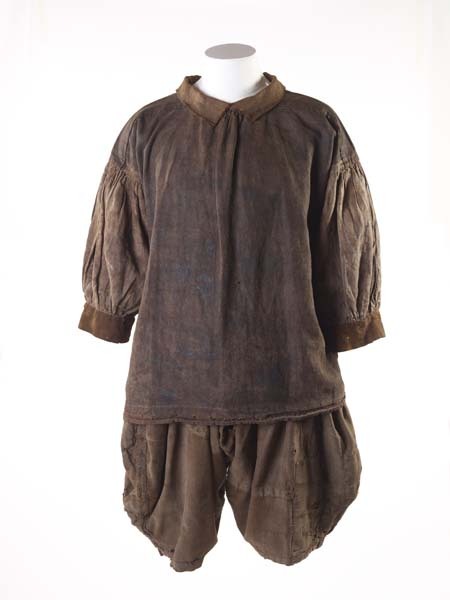

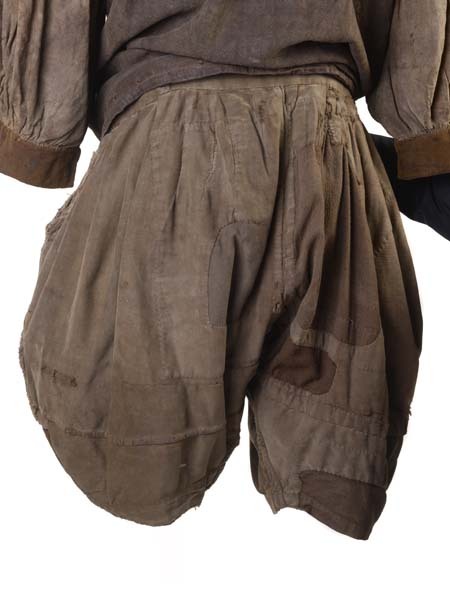
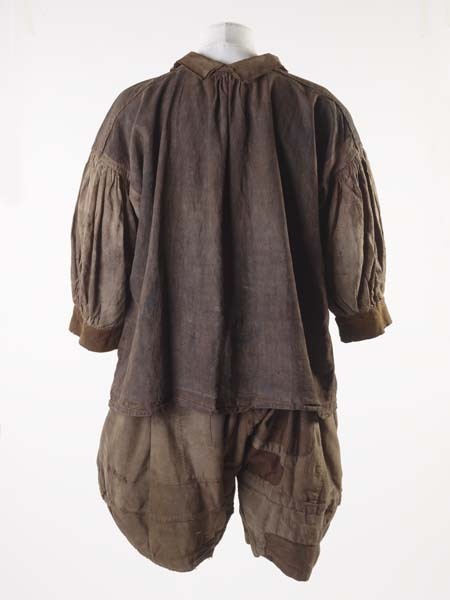
Sailor's Slops
1600s-1700s
Extremely rare survival of a shirt and breeches, called slops, as worn by sailors from the late 16th through to the 18th centuries. This unique set of loose, practical sailor’s clothing reveals life aboard ship. They are made of very strong linen to endure the hard, rough work. There is tar across the front from hauling ropes. The breeches are heavily mended and patched, which the sailor would have done himself.
The Museum of London (ID: 53.101/1b)
#shirt#breeches#menswear#fashion history#historical fashion#17th century#1600s#1610s#1620s#1630s#1640s#1650s#1660s#1670s#1680s#1690s#1700s#linen#brown#museum of london#popular
5K notes
·
View notes
Photo

A gentleman's embroidered blue silk frock coat, 1780s
15 notes
·
View notes
Text
time for an extremely specific fashion history question: does anybody have any references to what winter wear for common people looked like in western europe in approx the mid-1700s??? anything from around 1720-1780 would be an amazing help, especially menswear. just practical warm clothing and work wear for the outdoors.
I have been Googling for hours and I’m getting almost nothing useful, mostly just upper class fashion, which is basically the opposite of what I’m looking for
#fashion history#menswear#historical clothing#18th century fashion#18th century clothing#1700s clothing#1700s fashion#art reference
158 notes
·
View notes
Text
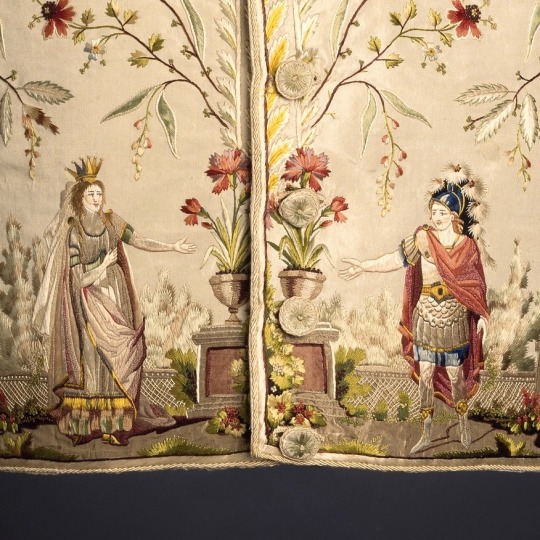
I’m in love with this embroidery detail
Waistcoat, France, circa 1785-95
White silk waistcoat with high stand collar and straight hem edge. Very deep border at front edges of a curving, flowering vine. At the bottom, embroidered figures in classical dress stand in front of a stone balustrade with urns of flowers and fruit trees. The figures represent Dido and Aeneas, from the opera by Piccini and Marmontel, produced in 1785. The figure of Dido is after a drawing by Jean-Michel Moreau le Jeune for the costume worn by Mlle. de Saint-Huberty. In twenty-five colors of silk.
#waistcoat#France#1780s#1790s#18th century#1700s#art#embroidery#fashion#pretty#French#French fashion#rococo#baroque#french art#history of fashion#sewing#clothing#men’s fashion#menswear#European art#beautiful#dido#Aeneas#Jean-Michel Moreau le Jeune#Mlle. de Saint-Huberty#mythology#roman mythology#Roman#detail
15 notes
·
View notes
Text

Ensemble
probably French ca. 1730
1 note
·
View note
Text



1600s MEN - LOOKBOOK
As in womenswear, early 17th century menswear styles maintained the basic features of late 16th century dress. However, come the 1610s romantic adornments and embellishments really started to explode in popularity. Rosettes were added to shoes, lace trimmed collars and cuffs, and sashes became a way to signify group membership in an era before military uniforms. While women's fashion became fuller, men's styles slimmed further and further until the silhouette was far removed from the boxy shape of the 1500s.
You can find more of my historical content here:
1300s ✺ 1400s ✺ 1500s ✺ 1600s ✺ 1700s
OUTFIT RESOURCES
King: Crown & Cloak | Hair | Top | Pants | Hose (Base Game) | Socks | Shoes
Chancellor: Hat | Hair | Facial Hair | Ruff | Cloak | Gown
Nobleman: Hat & Hair | Facial Hair | Top | Sash | Sword | Gloves (TSR) | Pants | Boots
Gentleman: Hat | Hair | Facial Hair | Bow | Top | Pants | Hose (Base Game) | Shoes
Musketeer: Hat | Hair (TSR) | Facial Hair (TSR) | Cloak | Outfit | Sword | Gloves (Get To Work)
Puritan: Hat (TSR) | Hair | Facial Hair | Top | Cloak | Cuffs | Pants | Hose | Shoes (TSR)
Merchant: Hat | Hair (TSR) | Facial Hair | Top | Sash | Gloves (Base Game) | Pants | Hose | Boots (Horse Ranch)
Artisan: Hat (TSR) | Hair | Facial Hair (TSR) | Top | Pants | Hose (Base Game) | Shoes
Commoner: Hat (TSR) | Hair (TSR) | Facial Hair (TSR) | Outfit | Socks | Shoes (Vintage Glamour)
Labourer: Hair (Discover University) | Hat | Top (TSR) | Pants | Hose (Base Game) | Shoes (Vintage Glamour)
Shepherd: Hat (Movie Hangout) | Hair (Journey to Batuu) | Facial Hair (Eco Lifestyle) | Top (Discover University) | Belt (TSR) | Pants & Boots
Peasant: Hat | Hair (retired - direct download) | Facial Hair | Top (Horse Ranch) | Pants | Boots (Spooky Stuff)
With thanks to some amazing creators: @revolution-sims @okruee @simverses @jius-sims @candysims4 @wistfulpoltergeist @valhallansim @acanthus-sims @isaax-sims @satterlly @simandy @elfdor @twentiethcenturysims @strangestorytellersims @studio-k-creation @zx-ta @igorstory @regina-raven @blahberry-pancake @imvikai @serenity-cc @marsmerizing-sims @ilkup @daylifesims @natalia-auditore
#ts4 historical#sims 4 historical#ts4 decades challenge#sims 4 decades challenge#ultimate decades challenge#sims 4#the sims 4#ts4 cc cas#ts4#the sims#ts4 cc#lookbook#historical cc#17th century#baroque#ts4 lookbook#sims 4 lookbook#s4 lookbook#ts4 history challenge#1600s
390 notes
·
View notes
Text
It is much more funny when I realize I was dressed like someone who needs to witness a public execution on the town square at 5 and attend a vampire council at 6.


A teenager just complimented my outfit.
I might be doing something right in my life
#shirt inspired by 1700s menswear split skirt and leather coat is definitelly something a slightly confused vampire would wear#cw: my face#i wanted to crop it completely but then you would miss the heart-shaped sunglasses
8 notes
·
View notes
Note
"especially given, y'know, what Sam wears in his day-to-day lol, I get the impression off the rack doesn't do much for him"
I don't usually pay close attention to men's fashion, so I was wondering if it was normal to have a shirt that seemed to fit well in the shoulders have SO much extra fabric around the waist lol
Do you remember any specific things that Carol said re: Sam? :) I've really loved reading her dives into the Louis/Claudia/Lestat Mardi Gras costumes and Louis and Claudia's 2.1 costumes.
Haha, it's kind of hard to tell, because the oversize fit for men is definitely in fashion right now, but his proportions do end up leaving him with so much fabric around the waist - he ends up looking a little concave when he sits back. I don't think it helps that he seems to like big, loose jackets too a lot of the time.
Carol's so great! I don't know if she's talked specifically about dressing Sam, but she talked a lot about the costuming for Louis, Lestat and Claudia in her AMC Q&A after s1 aired, and a bit in her more recent interview with TV Guide. They're both worth reading - the second one I found particularly interesting in what she said about Armand's neck always being exposed as a sign that he's at the top of the food chain and knows it (really contextualises a lot of the choices for other characters too!) and that Louis' muted style in Dubai is something Armand would see as Louis being able to relax with him, but is really a sign of Armand's control because Louis as a character likes, and is influenced by fashion.
Which feeds so nicely into the things she said about him and Lestat with their s1 looks in the AMC interviews. My favourite bits:
For Louis starting out, he had several iconic looks. His fashion showed how he was struggling between two sides of himself when Lestat found him. He had a Booker T. Washington look, a look that showcases the entrepreneurial spirit and celebration of education and Black business owners, and it was a more austere look. Then for his nightlife look, I was inspired by Black vaudeville. Not what the men were wearing on stage, but what the men were wearing in their lives, which Louis would have been aware of. They were extremely dapper men, and they had a celebrity air to them. In order to survive, Louis has to be impeccable. He has to have a showmanship about him that serves as a layer within his defense mechanisms. There were so many pieces to the puzzle that got us to where we were visually with both of Louis and Lestat. For Lestat, he's coming from the mid-to-late 1700s and that was during a real explosion of dandy fashion for men. It's like Beau Brummel, the most widely known male dandy fashion plate. As we move forward with Lestat, I looked at icons like Rudolph Valentino. We have to remember that Lestat is coming from a time when clothing was a lot more restrictive. He wears modern clothes, but they almost fit him like corsetry, even his suits.
And another quote below the cut!
As we got to know these characters, as the work progressed with Sam [Reid] and Jacob [Anderson], we would present them with different styles that I felt "this could be Louis," "this could be Lestat." We reached a point where in fittings it was like we instinctively knew "in this time period this is how Louis would actually wear it" and "this is how Lestat would wear it." So just in working with the actors, so much presented itself in what direction to go with each of the men. There was some really fun stuff of course, like when they first meet. They have very distinct looks and then Louis pulls Lestat into the present day, right? They have this moment – it's like their first honeymoon moment – of their friendship where Lestat is very influenced by Louis's fashion and he's going to Louis's tailor. They really feel in sync and that moment is largely illustrated by a very famous menswear illustrator, J.C. Leyendecker. He made famous the Arrow Shirt Man and he was the male standard of beauty. He became such a big thing that he sold millions of shirts just because everyone wanted to be that man in his illustrations. And the whole first two episodes, their style sense in many ways is a love letter to Leyendecker. Some things are just perfectly pulled from – like their formalwear, their tuxedos that they wear to the opera in 1917, and the black pinstripe suit with the green tie and the white boutonniere that Lestat wears to the du Lac family home for dinner – those are from a Leyendecker illustration. The thing that was so amazing about Leyendecker himself, was that the Arrow Shirt Man, his model, they fell in love and it was just a beautiful love story between these two men that they could not be public with. So, to throw in very pointed Leyendecker references in places of great struggle for Louis and Lestat was amazing. What I always think of as their second honeymoon is in the '20's when Claudia is running wild, and you see them and they’re like these two fabulous bachelor dads. That was a lot of fun! There's this one image – and there's been a fair amount of fan art – with Lestat in the cardigan sweater. That was so tongue-in-cheek! They're the perfect two dads with their little wild child. Putting those looks together was amazing. It was all about following the story and ripping them apart, and then putting them back together, and then ripping them apart and putting them back together again.
#there's just so many thoughtful talented people making this show#always obsessed with the idea of corsetry playing into all of lestat's clothes though#amc interview with the vampire#iwtv press#welcome to my ama
10 notes
·
View notes
Text
i haven’t updated like, anything about my life lately so here’s sort of what i’ve been up to since starting my phd??
dildo poetry from the 1600s and 1700s including a poem from 1735 called “the sappho-an” which is a kind of creation myth for the strap-on (fun fact: they had dildos which could simulate ejaculation back in the 1600s! they put milk in them)
research on 1500s and 1600s sex work in london
archival research about people arrested for wearing the “wrong” gender’s clothing in 1500s/1600s london (yay paleography!)
one case about both of the above, a sex worker named jane trosse who was also once caught out in menswear, and the court record for one of her cases includes the admission from a married couple that she was sleeping with both of them together (hooray historical threesomes!)
read like 25 plays from that period that include characters who transition between genders and that’s only like 1/3 of the plays i want to look at
have made multiple new lesbian friends (most important kind)
one of them saw my dnd stickers and asked if i play and now we have a gc called “phdnd” so we can get a game going
went to drag bingo with a different one who has a trans brother who knows my friend’s boyfriend bc the transfag world is Small sjgkdjg but he gave me a super cute acab sticker he designed
been watching glee but in french with my friend as a fun way to learn more french
i think that’s most of it tbh my life is 90% school right now bc it’s literally what i am paid to do
20 notes
·
View notes
Photo

Man's Suit (coat, waistcoat, and breeches) c. 1790 - France
7 notes
·
View notes
Text
so, thinking about points of inspiration for the different mechs, it’s not at all unreasonable for quite a lot of them to exist together in a (mostly) mundane historical au that keeps their backstory at least somewhat...
Like I’d say all of them but Carmilla and Aurora* can be traced back to a real Earth time and place, and a lot of those are technically close enough together for many of them to meet within natural human lifetimes. A timeline to demonstrate:
Between 100-1 BCE: Ivy, though the actual ending point of the Library of Alexandria is disputed. Caesar burned it in 48 BCE, but there’s evidence it still existed after that.
0 CE: Brian, if we’re assuming that Brian is space Jesus. Brian and Ivy could reasonably know each other in this case.
between 1300 CE and 1860 CE: Scuzz, though both these ends are fairly unlikely. From my research, it looks like the height of the ninja era in Japan was between 1400 CE-1640 CE.
1400-1500: Possibly Raphaella? She’s a mystery, but based on the advanced science, the angel imagery, and the name, I think there’s the most evidence to put her at some point in the italian renaissance.
circa 1500-1650: Brian, if we’re assuming Brian is a space witch. Most witch hunts occurred within this window. This would put any combination of Brian, Raph, and Scuzz as feasible friends!
1800s: Marius? Like Raph, he’s a mystery, and I am not an expert on historical menswear, but based on the outfit and the baron/doctor thing I think he’s probably at some point in this century.
1837-1901: Toy Soldier’s origin, assuming it’s a victorian automaton. It also does not necessarily have a reasonable death date, as it wasn’t made immortal by Dr. Carmilla.
1865-1895: Jonny
1914-1918: Tim
1918: The historical storming of the winter palace. If Nastya was irl Anastasia, this would put her as being born in 1901
1920s-1940s: Ashes, based on the timeline of the American mafia, which seems to be the point of inspiration. However, that organization was founded in 1861, and it’s theoretically possible for them to come from a time as late as the 1980s, but based on historical mob peaks and costuming, 20s-40s seems most likely.
So depending on exact times (and places where my information or analysis may be incorrect) it’s completely possible to write a historical mechs au set in the 1930s which features Marius and Jonny (possibly also scuzz) as being older, with Tim and Nastya as adults and Ashes as a young adult, and the toy soldier, as usual, present, all within reasonable human lifespans.
*I have a few vague, barely-formed ideas about Aurora, but those are based on like. a handful of words in the forbidden lore. and Carmilla’s post-apocalyptic origin makes it difficult for me to place her in a historical timeline; the future seems far more likely for her. However, if we’re going by the 1872 novel, she could have been born in the 1700s, and if she’s still a vampire could at least meet the majority of the others.
#the mechanisms#the mechs#i don't even know what to call this#meta?#jonny d'ville#nastya rasputina#ashes o’reilly#scuzz nishimura#ivy alexandria#drumbot brian#the toy soldier#gunpowder tim#marius von raum#raphaella la cognizi
176 notes
·
View notes
Text
Shoelaces

[Detail of the Meagre Company, oil on canvas, c. 1633-1637, by Frans Hals, via Wikimedia.]
While shoelaces had been fairly common in the 17th century by the beginning of the 18th century they had been surpassed in popularity by buckles.

[Detail of Declaration of Independence, oil on canvas, c. 1819, by John Trumbull, via Wikimedia.]
The most common style of men's shoe in the 18th century was black leather buckled shoes, typically with a small heel (see above). Even fashionable men often wore these simple black buckled shoes, though they may accessorise them with ornate buckles rather than plain ones. Even on men's high heels we see buckles replacing ribbons at the turn of the century.


[Left: Detail of Charles II of England, oil on canvas, c. 1670-1675, by Simon Pietersz Verelst, via Wikimedia.
Right: Detail of Louis XIV of France, oil on canvas, c. 1700-1701, by Hyacinthe Rigaud, via Wikimedia.]
During the first few decades of the 18th century shoe ties remained popular alongside buckles in women's footwear. However extant examples of buckled shoes outnumber those of laced shoes, though this may in part be due to shoes being converted to accommodate the fashionable buckle.

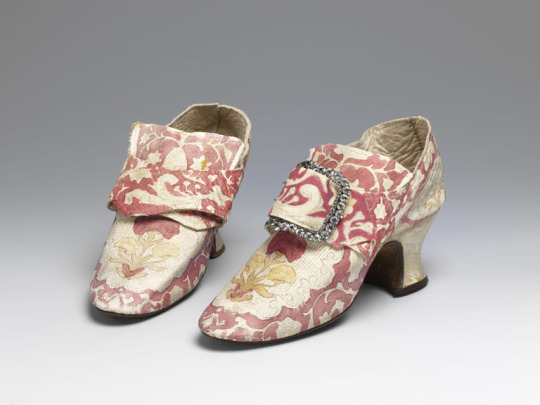
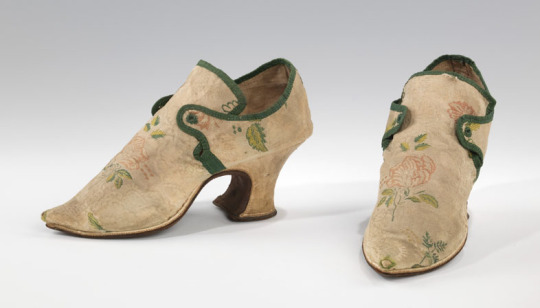
[Left: Shoes with ribbon ties, leather & brocaded silk, c. 1730s, via V&A (accession number: T.197&A-1927).
Middle: Buckled shoes, painted kid leather & silk, c. 1760s, via V&A, (accession number: 270&A-1891).
Right: Shoes with eyelets, leather & silk, c. 1700–1720, via The Met (accession number: 2009.300.1480a, b).]
In their description for the shoes on the right the Met writes:
Most aficionados of historic fashion are well acquainted with 18th century ladies' shoes in the classic buckled latchet style, as they survive in fairly good number. The predecessor of these - latchet ties shoes - are however fairly scarce in good unaltered condition. In order to extend their life as fashionable footwear, latchet tie shoes were frequently modified to accommodate a buckle.
By the 1780s shoe strings in menswear was so unpopular in mainstream Parisian fashion they were seen of being indicative of sodomy. In his article Commissioner Foucault, Inspector Noël, and the “Pederasts” of Paris, 1780-3 Jeffrey Merrick explains how Foucault and Noël used men's clothes to identify them as suspected sodomites. These men wore “some combination of frock coat, large tie, round hat, small chignon, and bows on the shoes.” Merrick speculates that these men were using fashion to signal to each other. Understandably when questioned by police men would deny such a purpose.
In England men who wore shoe strings were seen as effeminate. In their issue of 6-9th of December 1788 the St. James's Chronicle or the British Evening Post describes the "Jessamy or Petit-Maitre" (both terms for effeminate men) as follows:
The Jessamy or Petit-Maitre are so nearly allyed that the Rules that serve for one will do for the other-These He-She Beings should always take particular Care in the Decoration of their sweet Persons-Their Clothes should be cut to the very extreme of the Mode, their Hair dressed particularly nice, even if they sit two Hours under the Hairdresser's Hands, and while under the Operation, are to take out their Pocket Glass and give the Hair Dresser Instructions form Time to Time-When they walk the Streets of London, they are to make short Steps, as was formerly the Fashions of the fine Ladies, wear Shoe-Strings-paint their Faces, and be alarmed at every little Noise they hear in the Streets. In short it will be necessary to keep up their Reputation that they assume a Behaviour more feminine than masculine-and by all Means to imitate the Behaviour and Looks of the Females in the Days of their Great Grandmothers. Such Conduct will stamp their Characters in the Eyes of their Brethren.

[Sir John Coxe Hippisley, oil on canvas, c. 1779–80, by William Pars, via Art & the Country House.]
However by the late 1780s shoe strings were already starting to have a resurgence, in part due to their cost. With shoe strings being cheaper than buckles many men started to adopt them in spite of the associations with effeminacy. On the 21st September 1786 The Times reported:
The shoe-strings are now the fashion wit all the barbers boys, hair-dressers, and waiters, in London. The charity schools have also adopted them, as they are much cheaper than buckles. A man of sense, and a real man of fashion, has never yet dishonoured his instep with such a piece of mean folly.
And on the 12th of July 1787 The Times suggests that when a "tolerably well-dressed man wears them, the general conclusion is, that his buckles are in pawn." However in spite of the comparative cheapness of shoe strings the association with effeminacy persisted.
One intriguing instance of the cultural perception of shoe strings comes from a 1789 adaptation of the Tempest that opened on Drury Lane on Tuesday the 13th of October. The play included an epilogue written by General John Burgoyne. The epilogue fear-mongers the growth of effeminacy in England writing that "we may lack men, though over-run with males." Burgoyne depicts the middle class John Bull as an effeminate "He-Miss" Milliner:
Yet John sometimes his shape and sex degrades, And stoops to rob his sisters of their trades. Six feet in height, with sinews of an ox, Shoulders to carry coals, and fists to box,- Behold-O shame!-a thing of whip and hem- A He-Miss Millener-"Your orders, Me'm?- "Rouge, lipsalve, chicken gloves, perfumery, "Hair cushions, gauzes, bustles?-HE! he! he!"-
Burgoyne then shifts to men "of higher bearing";
Still Falstaff's men, all radish and cheese-paring!- Oh! could he sketch some figures that one sees- Tied up with strings at shoes and strings at knees! So thick the neck-cloth, and the neck so thin! He'd swear they bore a poultice for the chin:- And lest the cold the adjacent ears should harm, See half a foot of cape to keep 'em warm; While the stiff edge, for better purpose made, Rubs off the whiskers it was form'd to shade. With eyes of fire that vie with snuffs in sockets, And hands distress'd for want of waistcoat pockets: The crutch of levity directs their gait; And wanghee bends beneath their wangling weight.
On the 14th The World praises the epilogue as a "pleasant satyr upon modern modes" noting in particular;
the perversion of his good parts into effeminate pursuits-the Man-Milliner-the strings at shoes, and strings at knees-the stiff stand-up cape, "chasing the whisker it was meant to hide"-the waistcoat pockets-were all perfection, in what is the Epilogue's best praise, knowledge of effect, and strong accomplishment of it.
In contrast to Burgoyne's depiction of him as a "He-Miss Millener" John Bull, a personification of England (much like Uncle Sam is to the US), was typically depicted as a plainly dressed middle class Englishman. Some satires such as James Gillray's Politeness would compare the masculine English John Bull to the effeminate French archetype. Bull is depicted sitting with his legs open, wearing blue, red and buff with short un-powdered hair and wearing boots. The Frenchman is sitting with his legs closed, wearing pink and green (colours that were considered effeminate) with white powdered hair tied back with a ribbon and wig bag. However he is wearing bucked shoes.
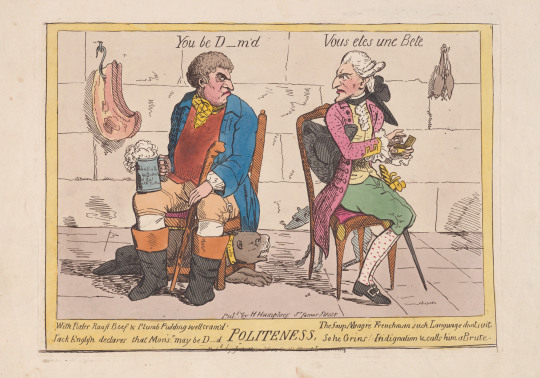
[Politeness, hand-coloured etching, c. 1779, copy after James Gillray, via The Met.]
Another example of a typical depiction of John Bull can be seen in The Honest Pickpocket published by William Holland which comments on the clock tax enacted by the Pitt government. The cartoon depicts Prime Minister William Pitt taking a watch out of John Bulls pocket. Pitt is saying "Don't be alarmed, Johnny, I only want to see whether it is Gold or Silver - you know there is a great deal of difference between Half a Crown and Ten Shillings."
In this anti-Pitt satire, Bull is depicted again in blue, red and buff with un-powdered hair, however this time he is wearing buckled shoes. Pitt in contrast is depicted in green with powdered hair tied back with a ribbon and wig bag. His shoes are fastened with strings.

[The Honest Pickpocket, hand-coloured etching, c. 1797, published by William Holland, via The British Museum.]
However in An Enquiry Concerning the Clock Tax Pitt is depicted in blue and red with buckled shoes. The satire is playing on a pun, the clock tax was a tax of the time keeping devices but in the 18th century stockings sometimes had decorative embroidery known as clocks. In the print a delegate "from the worthy and respectable Society of Hosiers" asks Pitt "to know whether your Honor means to extend the Tax to Clocks upon Stockings." In contrast to Pitt the hosier wears not only stockings with clocks, but also shoes with strings as well as breeches with strings at the knees. Pitt is holding a quill labeled "Tax Pen", he is halfway through writing a list of taxes which includes "Shoe Strings", "Knee Strings" and "Hair Strings".

[An Enquiry Concerning the Clock Tax, hand-coloured etching, c. 1797, after George Moutard Woodward, published by S. W. Fores, via The British Museum.]
While this satire was clearly playing on the pun, it's not too far off what some were proposing. With the popularity of shoe strings increasing during the 80s the buckle makers were starting to get concerned for their livelihood and hoped a shoe string tax would combat the price difference. On the 22nd of November 1788 The Times reported:
The buckle makers it is said intend to petition for a tax on shoe strings by an eighteen penny stamp on each pair. This, although somewhat extraordinary, yet is in agitation, and might be easily effected.
With most of the buckle manufacturing coming out of Birmingham it was reportedly a risky move to wear shoe strings there. On the 28th August 1789 the Oracle reported:
At Birmingham, the man who dares appear with ribband-ties in his shoes, is certain not to pass current. He is instantly seized, his shoes taken off and cut to pieces; and no shoe maker can dare to sell him a new pair, unless he buys a pair of buckles first!
Much of the public was on the side of the buckle makers and against the shoe strings. On the 12th August 1789 the Oracle bemoans that "thousands of His Majesty's loyal subjects are now starving, from the introduction of the effeminate fashion of shoe-strings." On the 6th of November the Oracle reported that on "being asked by a Nobleman, why he had such an objection to Shoe Strings-His Royal Highness replied in these emphatic words-"
In the first place, I dislike them, for they look effeminate, are neither genteel or becoming; but give a certain air of meanness to the foot, which should be avoided. In the next place, I do not wear them, for it shall never be said of me, that any whim of mine has been instrumental in bringing the hard labouring Mechanic to Ruin!
A letter signed "Cheapside" published on the 5th January 1789 in The World was a bit more extreme suggesting that men who wore shoe strings "ought, in plain English, and with a good sufficient English cord, to be hanged". While Cheapside was concerned that the buckle makers were being "tied up from getting their bread" the true dislike of shoe strings and the men who wore them seem to be more due the their "intimations" that were "most disgraceful to manhood."
#to my amerev followers yes its the same General John Burgoyne he became a playwright after the war#fashion history#queer history
56 notes
·
View notes
Note
9,11,47 for the ask post
9) Ideal Date
I don’t really have one tbh. I guess just a dinner would be nice.
11) Favorite style of clothing
I am pursuing a master’s in costume production and have a lot of feelings about clothing styles, *but* without going into too much depth, my absolute favorite era for menswear is the early 18th century (about 1700-1740s), along with the late 17th century and 1970s. My favorite era of womenswear would be the 1890s (I love a cunty sleeve) and the 1930s (very criminally underrated decade in fashion history). In terms of personal fashion, however, I like history-bounding/historical-inspired clothing, and my past few sewing projects have been in that aesthetic.
47) Grossest food you’ve ever had
Not a food, but I tried prosecco recently and it tasted like dry erase markers mixed with rubbing alcohol. I also *despise* chocolate in any form.
2 notes
·
View notes
Text
Madame Putiphar Readalong. Book One, Chapter Four:

Tinterne Abbey Doorway leading into the Sacristy. W. H. Bartlett. E. J. Roberts.
This week’s chapter was especially good. We get to see Borel at the top of his eclcectic writing genre-spanning game. There’s theatrical dialogue, impressionistic descriptions in broad brush strokes, carefully minute scenic descriptions lovingly painted with a fine brush, the succinct epigram of the 1700’s and the verbal overload of the baroque, a convincing portrayal of domestic violence immediately followed by farce, proto-surrealism... The splendid polyphony of the Romantic orchestra, unbridled.
I strongly reccomend reading it for yourselves. Text in English here!
We begin with Debby looking at herself in the mirror. She has to make sure there’s no trace of tears or pain in her expression before she is seen by her father at lunch.
It’s true that she has to hide her pain like her mother has begged of her. It’s best if Lord Cockermouth is left in the dark about their prior meeting.
But on another level we are seeing a woman having to hide unpalatable emotions under a socially acceptable mask. I find the whole image of Debby scrutinizing her face and dress, making futile attempts to suppress visible signs of the pain she’s feeling to be extremely eloquent. It’s very Romantic too, the duel of the instinctual/emotional versus social conventions.
Borel in his iconoclastic tale Passereau has his narrator exclaim “this is not a Rousseau story!”. But he seems to share with him a concern about the social constraints imposed on our natural, spontaneous reactions. (remember the also iconic paragraph in The Werewolf depicting the tight menswear of the day as a prison for the body) Emotions, if one looks beyond the very pragmatic reasons Debby and Lady Cockermouth have for masking and concealing, giving free reign to emotions is not socially acceptable. We will see later on how there is a double standard at work here, since Lord Cockermouth in one of my favorite passages in an overall very well written chapter, is completely allowed to just. Combust with rage.
Debby finally feels ready to face her parents, and arrives at the dinning room, where it’s her mother, her ambivalent ally who casts doubt on her, remarking on the lateness of her arrival. Her Father speaks in her mother’s ear about how bad Debby looks, how she seems like an insomniac. How she will break from too much exertion-he of course means, excessive sexual escapades with Patrick. Debby knows her parents well, and with just one look she
“(...) sensed the tempest; and shaking like a bird surprised by a storm, she went and curled up in a chair.”
The chapter is full of perfectly succinct lines such as this which paint the scene perfectly without need of long winded descriptions. It’s poetic while also very visual. We can picture her attitude: swift, shrinking herself, bringing all eyes on her from trying too hard to be unnoticed. His father pierces with his relentless, invasive gaze.
Borel employs for Cockermouth’s lines theatrical asides. He says one thing aloud for Debby to hear, and something else in a lower tone, into his wife’s ear that reveals his true intentions. His asides are usually derisive comments implying how his daughter is a nymphomaniac. He asks about what he perceives is a symptom: her red eyes, her lack of sleep, her lack of appetite, and diagnosticates her: the cause of the symptoms is constantly deemed to be excessive sexual appetite and activity. And the cure? Well, he would crush her, if it weren’t for his hability to show restraint (we will see about this restraint soon enough).
He finally stops with the pretence and calls her a prostitute to her face. He vanishes her from the dinning room. Debby cries, her mother defends her, the verbal abuse turns physical. Lord Cockermouth throws a pewter cup at Debby’s shoulder. She cries out, which enrages him. (this is also perfect psychology, the abuser angered at the expression of his victim’s pain, a mirror painfully reflecting his brutality back at him. It also follows the theme of the social etiquette of women hiding their discomfort we saw earlier. It would perhaps be preferable if Debby would just take the abuse without complaining, avoiding her abuser any discomfort)
What follows is a very visual, almost farcical description of Cockermouth anger. Again, it’s just a single line, but you can see it all: a blurry red mass of a man raising himself from the table, toppling it over with his massive belly, breaking everything in his way while storming out like a hurricane, shouting out insults, slamming the door of his room, making it all about himself. He is, evidently, the wronged party.
Debby flees to her room as well. Her brian shuts down from the trauma. She falls asleep, completely drained. This type of scene is not new for her, since she has, from the days of her childhood, seen her father abuse her mother, the narrator tells us. But for the first time she was more than a supernumerary, she was pushed center stage to perform a leading role in the theatre of domestic violence, and feared it’s final act.
A servant finds her asleep when bringing her dinner. He has a note from her mother. She begs her not to meet Patrick that night.
The request triggers an inner monologue. Debby’s exhausted brain rebels not at her mother’s plea, but at the mere idea of breaking up with Patrick. We get poetic repetitions: (Oh! c’est là de ces choses auxquelles mon esprit se refuse! Oh! c’est là de ces pensées dont mon intelligence bornée s’effarouche?—Moi! te donner congé, Patrick! comprends-tu?) She calls her love for Patrick the vulture that grasps her in its claws, a jailer that piles her up with chains. And the imagery grows more and more surreal. “L’enfant peut briser son jouet, mais le jouet peut-il briser l’enfant?... Eh! que suis-je!...—Une meule peut-elle se broyer elle-même? Un arbre peut-il se déraciner? Une vallée peut-elle dominer le mont qui la domine?... Et moi! puis-je engouffrer l’abyme qui m’engouffre?...” We cannot easily picture the action of a molar grinding itself, a tree uprooting itself, the imagery is not rooted in logic. It’s a challenge to the reader. The images undoubtedly remit to the idea of self destruction. Turning Patrick away would amount to self amputation. That uncontrollable force which dominates her is also what is keeping her alive.
After a few bites of a piece of bread, Debby mechanically puts on a cape and leaves her room.
We get some very precise architectonic terminology to describe Cockermouth Castle. If the raging lunch was all Goya’s rage and fury in broad brush strokes, here we get really close to the canvas for a minute description of the gothic fortress. (Borel was an architect, and he had a special spot for gothic architecture in his heart, so we get a detailed description of the evolution of the styles currently surrounding Debby)(the functional military crenels had given way to a rich baluster in a neoclassical belvedere style, designed for strolls and contemplation -erasing the gothic, thought of at the time as a barbaric style is one of Borel’s pet peeves as seen in his essay The Luxor Obelisk-)(which shows us that times of war have given way to times of peace at least for the Lords of the land. The growing power of the Cockermouths, of England in the area, makes them confident enough not to expect attacks any time soon)
The castle dominates over a barren red and black plain. There’s peripheral poverty, as seen by the very precarious little cottages half buried by the soil. We seem to be now in a Caspar Friedrich painting, or a Piranesi wasteland. Desolation, deserted land, ruins of ancient towers, churches, monasteries.... The viewer, we are told, -to a surprising effect-finds solace in this vision, the double edged blade of the sublime. The gaze is enchanted, and the mind is transported to the past.
We get a wonderful description of a cascade called The Devil’s Throat and its lore. The water flows cold in summer, warm in winter, and all kinds of miraculous cures have been attributed to it. But, the narrator bitterly adds, its most irrefutable property is that of curing anyone foolish enough to bathe in it of the illness of life.
The narrator is made aware of the limit of his art while trying to describe the vision of the sunset seen from behind the cascade, enhanced by seeing it from that long and sombre balustrade gallery ending in a gothic rosette which has nothing to envy from the sun. (architecture and nature perfectly mirror one another, they are both equally sublime and enhance each other’s sublimity)
Debby sees these wonders and remembers all the times she has endlessly, insatiably gazed at them with Patrick. Debby finds their initials and dates significant to them, engraved by Patrick on the rocks of the tower, in those meetings where only the heavens, which aren’t mocking or perfidious could hear them.
Debby could also see, from this privileged crow’s nest, while a thousand golden threads sprung from her eyes like a spider’s web, all their favorite spots where they had shared a favorite book, or had “herborized” together. (@sainteverge called our attention to the word: herboriser used to carry the meaning of ivy growing over rocks or statues, tangling and entwining until it’s impossible to tell where one begins and the other ends)
The chapter ends with Debby’s threads of gold scanning the cartography of her love. Even if she does not own the fortress, these oasis have been claimed by her and her Patrick’s herborizing.
#madame putiphar#putiphar posting#long post#text post#ooof i loved this one#the imagery is so gorgeous#the chapter reads like a collection of paintings siiigh#perfection#domestic abuse cw#violence cw#excuse the occasional corniness of this recap xD
8 notes
·
View notes
Text
dr cid was like, if a cartoon mad scientist and shakespeare's collective works had a baby who was a very bad father, and extremely loud. he was like if every menswear trend from between 1700 - 1865 was happening on his body simultaneously. they got him in a room and used the results to write the diagnostic criteria for BIG autism, a new type of autism they are testing out. then they cancelled him, which is sad, but there's other guys:
maerchen is like the demure and beautiful yet simultaneously blunt and tactless personification of a victorian woman's late stage tuberculosis, or if sighing wanly was a human man (?). he invented having long slender legs and looking frail in a graveyard, but by accident, because he is the other kind of autistic (oblivious). possessed of the cold and severe yet delicate and transient beauty of an ice sculpture and the inward demeanor of a build a bear accidentally supplied with two hearts' worth of love. hypnotically german, mesmerizingly catholic-goth
emet-selch is what would happen if an aging broadway starlet who ate cigarettes for breakfast and went through significantly younger boyfriends like changes of underwear was also a cisgender man who listened to the smiths. unfortunately i think he is allistic, perhaps dangerously so, but to make up for this he has perfected the art of having horribly smudged mascara from a night of drunken sobbing and somehow turning it into a sexy statement. he is like a polished refined-masculine CEO from bad self-published straight kindle erotica, but if that CEO was also a gay roman emperor who was a depressed drag queen.
what is the through line here? i'm a homosexual
3 notes
·
View notes